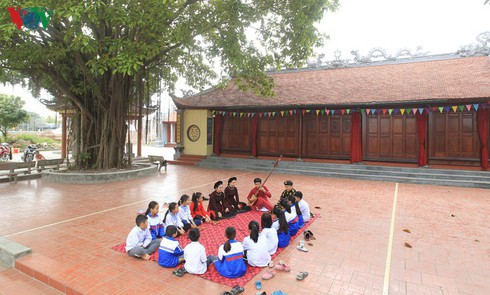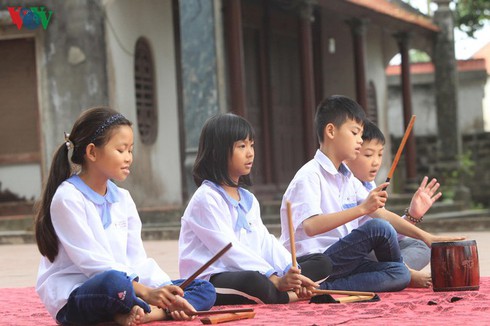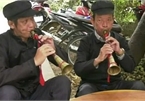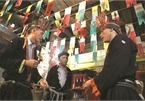 |
|
A Ca Tru singing class on a Saturday afternoon at Dong Mon village's temple.
|
A former Ca Tru singing mainstay with many famous female singers and lute players, Dong Mon has made Ca Tru singing an essential part of the locals’ daily life over the past 2 centuries.
For many years, Dong Mon’s ‘Ca Tru’ club has discovered, trained, and brought to fame dozens of young Ca Tru singers, while rekindling the passion for Ca Tru singing among young villagers. Do Thi Yen and Nguyen Kim Ngan, students of the Hoa Binh 2 elementary school, say they always look forward to the village’s Ca Tru classes every Saturday afternoon.
"After attending Ca Tru classes for 3 months, I’ve learned to use phach, a wooden castanet, and sing simple lines. My grandparents have told me about the history of Ca Tru in Dong Mon village and I wish to keep that tradition alive," said Yen.
"My mother has taught me Ca Tru singing since I was a first grader. I like it a lot. I learned to sing Ca Tru at the village’s communal hall every week, and sometimes I accompany my mother in performances of Ca Tru singing,” said Ngan.
According to historical records, Ca Tru was first introduced to Dong Mon over 200 years ago by To Tien, head of a Ca Tru singing guild from Kinh Mon, formerly of Hai Duong province. He asked major Ca Tru singing guilds across Vietnam to worship two Ca Tru ancestors, Your Grace Dinh Du Thanh Xa and Princess Man Duong Hoa, in Dong Mon village’s temple, and trained many of the region’s famous female vocalists and lute players.
Accompanying the female vocal in each Ca Tru performance is a man who plays the ‘dan day’, a long-necked, 3-string, lute used almost exclusively for the Ca Tru genre. During the 1940s, the art of Ca Tru singing thrived in Dong Mon with dozens of singing guilds established by local families and clans. To Van Tuyen, a descendant of To Tien, won the “Talented lute player” award during the 2018 National Ca Tru Festival.
 |
|
Dong Mon's young kids love Ca Tru singing and want to keep the tradition alive.
|
“Children in Dong Mon used to learn Ca Tru at a very young age and made a living from it. You can hear the sound of the lute and phach when entering the village gate. Many talented vocalists and lute players from Dong Mon went to other regions and opened their own inns,” he said.
During the war, people of Dong Mon set aside their love for Ca Tru and joined national salvation campaigns. The art of Ca Tru singing was revived around 1992 and 1993, thanks to the effort of many Dong Mon artists. Nowadays, Ca Tru performances are compulsory in Dong Mon during the lunar New Year Festival or Tet, and also during the death anniversary of the two Ca Tru ancestors, communal activities, and even in school.
Trinh Thi Hoai, a songstress and Ca Tru singing teacher to students of Hoa Binh 1 elementary school, told VOV "Our school has organized many activities to promote Ca Tru singing among students. Preparations are being made for a project at the district level to protect and promote this special art form of Vietnam.”
”Students’ Ca Tru performances are very popular in many school events such as Teachers’ Day on November 20 and International Women’s Day on March 8."
Ca Tru singing is not only part of Dong Mon people’s lives, but has also become an important cultural staple of the region. It reflects the local people’s characteristics and aesthetic values while contributing to cultivating their sense of beauty. VOV5

Pi Le panpipe, a traditional musical instrument of the Giay
The Giay in Bat Xat district, Lao Cai province, have a rich culture that includes music and musical instrument. The Pi Le clarinet is a typical woodwind instrument of the Giay.

Traditional ceremony marks coming of age
The ceremony has been held for hundreds of years, honouring the principles of marriage, family happiness and uniting people in their family and community.
 Dong Mon village in Hai Phong city is known as the cradle of Ca Tru (ceremonial) singing in Vietnam’s northern coastal region.
Dong Mon village in Hai Phong city is known as the cradle of Ca Tru (ceremonial) singing in Vietnam’s northern coastal region.